Otoplasty
Otoplasty is commonly performed at plastic surgicentre in Doha, Qatar.
If you’re considering ear surgery…
Ear surgery, or otoplasty, is usually done to set prominent ears back closer to the head or to reduce the size of large ears.
For the most part, the operation is done on children between the ages of four and 14. Ears are almost fully grown by age four, and the earlier the surgery, the less teasing and ridicule the child will have to endure. Ear surgery on adults is also possible, and there are generally no additional risks associated with ear surgery on an older patient.
If you’re considering ear surgery for yourself or your child, this information will give you a basic understanding of the procedure-when it can help, how it’s performed, and what results you can expect. It can’t answer all of your questions, since a lot depends on your individual circumstances. Please be sure to ask Dr. Makki if there is anything you don’t understand about the procedure.
ALL SURGERY CARRIES SOME UNCERTAINTY AND RISK
When ear surgery is performed by a qualified, experienced surgeon, complications are infrequent and usually minor. Nevertheless, as with any operation, there are risks associated with surgery and specific complications associated with this procedure.
A small percentage of patients may develop a blood clot on the ear. It may dissolve naturally or can be drawn out with a needle.
Occasionally, patients develop an infection in the cartilage, which can cause scar tissue to form. Such infections are usually treated with antibiotics; rarely, surgery may be required to drain the infected area.
PLANNING FOR SURGERY
Most surgeons recommend that parents stay alert to their child’s feelings about protruding ears; don’t insist on the surgery until your child wants the change. Children who feel uncomfortable about their ears and want the surgery are generally more cooperative during the process and happier with the outcome.
In the initial meeting, Dr. Makki will evaluate your child’s condition, or yours if you are considering surgery for yourself, and recommend the most effective technique. He will also give you specific instructions on how to prepare for surgery.
WHERE THE SURGERY WILL BE PERFORMED
Ear surgery is usually performed as an outpatient procedure at Plastic Surgicentre. Occasionally, Dr. Makki may recommend that the procedure be done as an inpatient procedure, in which case you can plan on staying overnight in the hospital.
TYPES OF ANESTHESIA
If your child is young, Dr. Makki may recommend general anesthesia, so the child will sleep through the operation. For older children or adults, Dr. Makki may prefer to use local anesthesia, combined with a sedative, so you or your child will be awake but relaxed.
THE SURGERY
Ear surgery usually takes about two to three hours, although complicated procedures may take longer. The technique will depend on the problem.
With one of the more common techniques, Dr. Makki makes a small incision in the back of the ear to expose the ear cartilage. He will then sculpt the cartilage and bend it back toward the head. Non-removable stitches may be used to help maintain the new shape. Occasionally, Dr. Makki will remove a larger piece of cartilage to provide a more natural-looking fold when the surgery is complete.
Another technique involves a similar incision in the back of the ear. Skin is removed and stitches are used to fold the cartilage back on itself to reshape the ear without removing cartilage.
In most cases, ear surgery will leave a faint scar in the back of the ear that will fade with time. Even when only one ear appears to protrude, surgery is usually performed on both ears for a better balance.
GETTING BACK TO NORMAL
Adults and children are usually up and around within a few hours of surgery, although you may prefer to stay overnight in the hospital with a child until all the effects of general anesthesia wear off.
The patient’s head will be wrapped in a bulky bandage immediately following surgery to promote the best molding and healing. The ears may throb or ache a little for a few days, but this can be relieved by medication.
Within a few days, the bulky bandages will be replaced by a lighter head dressing similar to a headband. Be sure to follow Dr. Makki’s directions for wearing this dressing, especially at night.
Stitches are usually removed, or will dissolve, in about a week.
Any activity in which the ear might be bent should be avoided for a month or so. Most adults can go back to work about five days after surgery. Children can go back to school after seven days or so, if they’re careful about playground activity. You may want to ask your child’s teacher to keep an eye on the child for a few weeks.
OTHER EAR PROBLEMS
Besides protruding ears, there are a variety of other ear problems that can be helped with surgery. These include: “lop ear,” when the tip seems to fold down and forward; “cupped ear,” which is usually a very small ear; and “shell ear,” when the curve in the outer rim, as well as the natural folds and creases, are missing. Surgery can also improve large or stretched earlobes, or lobes with large creases and wrinkles. Surgeons can even build new ears for those who were born without them or who lost them through injury.
Sometimes, however, the correction can leave a scar that’s worse than the original problem. Ask Dr. Makki about the effectiveness of surgery for your specific case.
MORE NATURAL-LOOKING EARS
Most patients, young and old alike, are thrilled with the results of ear surgery. But keep in mind, the goal is improvement, not perfection. Don’t expect both ears to match perfectly-perfect symmetry is both unlikely and unnatural in ears. If you’ve discussed the procedure and your expectations with Dr. Makki before the operation, chances are, you’ll be quite pleased with the result.
The information on this web site is only intended as an introduction to this procedure and should not be used to determine whether you will have the procedure performed nor as a guarantee of the result.
The best method of determining your personal options is to schedule a personal consultation with Dr. Makki. He will be able to answer specific questions related to your situation.
Please don’t hesitate to call for any questions that you might have
Face lifting (Rhytidectomy)
Face lifting is commonly performed at plastic surgicentre in Doha, Qatar.

A facelift can improve the deep cheek folds, jowls, and loose, sagging skin around the neck that come with age.
As people age, the effects of gravity, exposure to the sun, and the stresses of daily life can be seen in their faces. Deep creases form between the nose and mouth; the jaw line grows slack and jowly; folds and fat deposits appear around the neck. A facelift (technically known as rhytidectomy) can’t stop this aging process. What it can do is “set back the clock,” improving the most visible signs of aging by removing excess fat, tightening under lying muscles, and re-draping the skin of your face and neck. A facelift can be done alone, or in conjunction with other procedures such as a forehead lift, eyelid surgery, or nose reshaping. If you’re considering a facelift, the following information will give you a basic understanding of the procedure-when it can help, how it’s performed, and what results you can expect. It can’t answer all of your questions, since a lot depends on the individual patient and the surgeon. Please ask your surgeon about anything you don’t understand.
The best candidates for a facelift
The best candidate for a facelift is a man or woman whose face and neck have begun to sag, but whose skin still has some elasticity and whose bone structure is strong and well defined. Most patients are in their forties to sixties, but facelifts can be done successfully on people in their seventies or eighties as well. A facelift can make you look younger and fresher, and it may enhance your self-confidence in the process. But it can’t give you a totally different look, nor can it restore the health and vitality of your youth. Before you decide to have surgery, think carefully about your expectations and discuss them with your surgeon.
All surgery carries some uncertainty and risk
When a facelift is performed by a qualified plastic surgeon, complications are infrequent and usually minor. Still, individuals vary greatly in their anatomy, their physical reactions, and their healing abilities, and the outcome is never completely predictable. Complications that can occur include hematoma (a collection of blood under the skin that must be removed by the surgeon), injury to the nerves that control facial muscles (usually temporary), infection, and reactions to the anesthesia. Poor healing of the skin is most likely to affect smokers. You can reduce your risks by closely following your surgeon’s advice both before and after surgery.
Planning your surgery
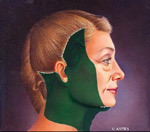
Incisions usually begin above the hairline at the temples, follow the natural line in front of the ear, curve behind the earlobe into the crease behind the ear, and into or along the lower scalp
Facelifts are very individualized procedures. In your initial consultation Dr Makki will evaluate your face, including the skin and underlying bone, and discuss your goals for the surgery. Your surgeon should check for medical conditions that could cause problems during or after surgery, such as uncontrolled high blood pressure, blood clotting problems, or the tendency to form excessive scars. Be sure to tell your surgeon if you smoke or are taking any drugs or medications, especially aspirin or other drugs that affect clotting. If you decide to have a facelift, Dr Makki will explain the techniques and anesthesia he will use, the type of facility where the surgery will be performed, and the risks and costs involved. Don’t hesitate to ask your doctor any questions you may have, especially those regarding your expectations and concerns about the results.
Preparing for your surgery
Dr Makki will give you specific instructions on how to prepare for surgery, including guidelines on eating and drinking, smoking, and taking or avoiding certain vitamins and medications. Carefully following these instructions will help your surgery go more smoothly. If you smoke, it’s especially important to stop at least a week or two before and after surgery; smoking inhibits blood flow to the skin, and can interfere with the healing of your incision areas. If your hair is very short, you might want to let it grow out before surgery, so that it’s long enough to hide the scars while they heal. Whether your facelift is being done on an outpatient or inpatient basis, you should arrange for someone to drive you home after your surgery, and to help you out for a day or two if needed.
Where your surgery will be performed
A facelift may be performed in a surgeon’s office-based facility, an outpatient surgery center, or a hospital. It’s usually done on an outpatient basis, but some surgeons may hospitalize patients for a day when using general anesthesia. Certain conditions such as diabetes or high blood pressure should be monitored after surgery, and may also require a short inpatient stay.
Types of anesthesia
Most facelifts are performed under local anesthesia, combined with a sedative to make you drowsy. You’ll be awake but relaxed, and your face will be insensitive to pain. (However, you may feel some tugging or occasional discomfort.) Some surgeons prefer a general anesthesia. In that case, you’ll sleep through the operation.
The surgery

Facial, neck tissue and muscle may be separated; fat may be trimmed or suctioned and underlying muscle may be tightened.
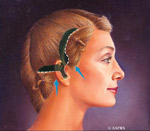
After deep tissue are tightened, the excess skin is pulled up and back, trimmed and sutured into place.
A facelift usually takes several hours-or somewhat longer if you’re having more than one procedure done. For extensive procedures, some surgeons may schedule two separate sessions. Every surgeon approaches the procedure in his or her own way. Some complete one side of the face at a time, and others move back and forth between the sides. The exact placement of incisions and the sequence of events depends on your facial structure and your surgeon’s technique. Incisions usually begin above the hairline at the temples, extend in a natural line in front of the ear (or just inside the cartilage at the front of your ear), and continue behind the earlobe to the lower scalp. If the neck needs work, a small incision may also be made under the chin. In general, the surgeon separates the skin from the fat and muscle below. Fat may be trimmed or suctioned from around the neck and chin to improve the contour. The surgeon then tightens the underlying muscle and membrane, pulls the skin back, and removes the excess. Stitches secure the layers of tissue and close the incisions; metal clips may be used on the scalp. Following surgery, a small, thin tube may be temporarily placed under the skin behind your ear to drain any blood that might collect there. The surgeon may also wrap your head loosely in bandages to minimize bruising and swelling.
After your surgery

Most of the scars will be hidden within your hair and in the normal creases of your skin.
There isn’t usually significant discomfort after surgery; if there is, it can be lessened with the pain medication prescribed by your surgeon. (Severe or persistent pain or a sudden swelling of your face should be reported to your surgeon immediately.) Some numbness of the skin is quite normal; it will disappear in a few weeks or months. Your doctor may tell you to keep your head elevated and as still as possible for a couple of days after surgery, to keep the swelling down. If you’ve had a drainage tube inserted, it will be re moved one or two days after surgery. Bandages, when used, are usually removed after one to five days. Don’t be surprised at the pale, bruised, and puffy face you see. Just keep in mind that in a few weeks you’ll be looking normal. Most of your stitches will be removed after about five days. Your scalp may take longer to heal, and the stitches or metal clips in your hairline could be left in a few days longer.
Getting back to normal
You should be up and about in a day or two, but plan on taking it easy for the first week after surgery. Be especially gentle with your face and hair, since your skin will be both tender and numb, and may not respond normally at first. Your surgeon will give you more specific guidelines for gradually resuming your normal activities. They’re likely to include these suggestions: Avoid strenuous activity, including sex and heavy housework, for at least two weeks (walking and mild stretching are fine); avoid alcohol, steam baths, and saunas for several weeks; limit your exposure to the sun for several months. Above all, get plenty of rest and allow your body to spend its energy on healing. At the beginning, your face may look and feel rather strange. Your features may be distorted from the swelling, your facial movements may be slightly stiff, and you’ll probably be self-conscious about your scars. Some bruising may persist for two or three weeks, and you may tire easily. It’s not surprising that some patients are disappointed and depressed at first. By the third week, you’ll look and feel much better. Most patients are back at work about ten days to two weeks after surgery. If you need it, special camouflage makeup can mask most bruising that remains.
Your new look

After surgery, you’ll present a fresher, more youthful face to the world.
The chances are excellent that you’ll be happy with your facelift-especially if you realize that the results may not be immediately apparent. Even after the swelling and bruises are gone, the hair around your temples may be thin and your skin may feel dry and rough for several months. Men may find they have to shave in new places-behind the neck and ears-where areas of beard growing skin have been repositioned.
You’ll have some scars from your facelift, but they’re usually hidden by your hair or in the natural creases of your face and ears. In any case, they’ll fade with time and should be scarcely visible.
Having a facelift doesn’t stop the clock. Your face will continue to age with time, and you may want to repeat the procedure one or more times-perhaps five or ten years down the line. But in another sense, the effects of even one facelift are lasting; years later, you’ll continue to look better than if you’d never had a facelift at all.
The information on this web site is only intended as an introduction to this procedure and should not be used to determine whether you will have the procedure performed nor as a guarantee of the result.
The best method of determining your personal options is to schedule a personal consultation with Dr. Makki. He will be able to answer specific questions related to your situation.
Please don’t hesitate to call for any questions that you might have
Rhinoplasty
The ideal nose today is a natural looking nose that fits the face.
Rhinoplasty is one of the commonest procedures performed at plastic surgicentre in Doha, Qatar.
If you’re considering rhinoplasty:
Rhinoplasty, or surgery to reshape the nose, is one of the most common of all plastic surgery procedures. Rhinoplasty can reduce or increase the size of your nose, change the shape of the tip or the bridge, narrow the span of the nostrils, or change the angle between your nose and your upper lip. It may also correct a birth defect or injury, or help relieve some breathing problems.
If you’re considering rhinoplasty, this information will give you a basic understanding of the procedure-when it can help, how it’s performed, and what results you can expect. It can’t answer all of your questions, since a lot depends on the individual patient and the surgeon. Please ask Dr Makki about anything you don’t understand.
THE BEST CANDIDATES FOR RHINOPLASTY

Before surgery, these rhinoplasty patients have large, slightly hanging noses, with a hump and an enlarged tip
Rhinoplasty can enhance your appearance and your self-confidence, but it won’t necessarily change your looks to match your ideal, or cause other people to treat you differently. Before you decide to have surgery, think carefully about your expectations and discuss them with your surgeon.
The best candidates for rhinoplasty are people who are looking for improvement, not perfection, in the way they look. If you’re physically healthy, psychologically stable, and realistic in your expectations, you may be a good candidate.
Rhinoplasty can be performed to meet aesthetic goals or for reconstructive purposes-to correct birth defects or breathing problems.
Age may also be a consideration. Many surgeons prefer not to operate on teenagers until after they’ve completed their growth spurt-around 14 or 15 for girls, a bit later for boys. It’s important to consider teenagers’ social and emotional adjustment, too, and to make sure it’s what they, and not their parents, really want.
ALL SURGERY CARRIES SOME UNCERTAINTY AND RISK
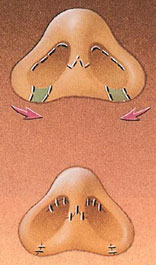
If your nostrils are too wide, the surgeon can remove small wedges of skin form their base, bringing them closer together
When rhinoplasty is performed by a qualified plastic surgeon, complications are infrequent and usually minor. Nevertheless, there is always a possibility of complications, including infection, nosebleed, or a reaction to the anesthesia. You can reduce your risks by closely following Dr Makki’s instructions both before and after surgery.
After surgery, small burst blood vessels may appear as tiny red spots on the skin’s surface; these are usually minor but may be permanent. As for scarring, when rhinoplasty is performed from inside the nose, there is no visible scarring at all; when an “open” technique is used, or when the procedure calls for the narrowing of flared nostrils, the small scars on the base of the nose are usually not visible.
In about one case out of ten, a second procedure may be required-for example, to correct a minor deformity. Such cases are unpredictable and happen even to patients of the most skilled surgeons. The corrective surgery is usually minor.
PLANNING YOUR SURGERY
Good communication between you and your physician is essential. In your initial consultation, Dr. Makki will ask what you’d like your nose to look like, evaluate the structure of your nose and face, and discuss the possibilities with you. He will also explain the factors that can influence the procedure and the results. These factors include the structure of your nasal bones and cartilage, the shape of your face, the thickness of your skin, your age, and your expectations.
Dr. Makki will also explain the techniques and anesthesia he will use, the type of facility where the surgery will be performed, the risks and costs involved, and any options you may have. Most insurance policies don’t cover purely cosmetic surgery; however, if the procedure is performed for reconstructive purposes, to correct a breathing problem or a marked deformity, the procedure may be covered. Check with your insurer, and obtain pre-authorization for your surgery.
Be sure to tell Dr. Makki if you’ve had any previous nose surgery or an injury to your nose, even if it was many years ago. You should also inform Dr. Makki if you have any allergies or breathing difficulties; if you’re taking any medications, vitamins, or recreational drugs; and if you smoke.
Don’t hesitate to ask Dr. Makki any questions you may have, especially those regarding your expectations and concerns about the results.
PREPARING FOR YOUR SURGERY
Dr. Makki will give you specific instructions on how to prepare for surgery, including guidelines on eating and drinking, smoking, taking or avoiding certain vitamins and medications, and washing your face. Carefully following these instructions will help your surgery go more smoothly.
While you’re making preparations, be sure to arrange for someone to drive you home after your surgery and to help you out for a few days if needed.
WHERE YOUR SURGERY WILL BE PERFORMED
Rhinoplasty may be performed in a surgeon’s office-based facility, an outpatient surgery center, or a hospital. It’s usually done on an outpatient basis, for cost containment and convenience. Complex procedures may require a short inpatient stay.
TYPES OF ANESTHESIA
Rhinoplasty can be performed under local or general anesthesia, depending on the extent of the procedure and on what you and Dr. Makki prefer.
With local anesthesia, you’ll usually be lightly sedated, and your nose and the surrounding area will be numbed; you’ll be awake during the surgery, but relaxed and insensitive to pain. With general anesthesia, you’ll sleep through the operation.

Incisions are made inside the nostrils or at the base of the nose, providing access to the cartilage and bone, which can then be sculpted into shape

The surgeon removes the hump using a chisel or a rasp, then brings the nasal bones together to form a narrower bridge. Cartilage is trimmed to reshape the tip of the nose.
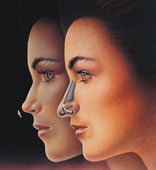
Trimming the septum improves the angle between the nose and upper lip
THE SURGERY
Rhinoplasty usually takes an hour or two, though complicated procedures may take longer. During surgery the skin of the nose is separated from its supporting framework of bone and cartilage, which is then sculpted to the desired shape. The nature of the sculpting will depend on your problem and your surgeon’s preferred technique. Finally, the skin is redraped over the new framework.
Many Rhinoplasty operations can be performed from within the nose, making the incision inside the nostrils. Other cases will be performed by an “open” procedure, especially in more complicated cases; where we make a small incision across the columella, the vertical strip of tissue separating the nostrils.
When the surgery is complete, a splint will be applied to help your nose maintain its new shape. Nasal packs or soft plastic splints also may be placed in your nostrils to stabilize the septum, the dividing wall between the air passages.
AFTER YOUR SURGERY

A splint made of tape and an overlay of plastic, metal, or plaster is applied to help the bone and cartilage of the nose maintain their new shape.
After surgery-particularly during the first twenty-four hours-your face will feel puffy, your nose may ache, and you may have a dull headache. You can control any discomfort with the pain medication prescribed by your surgeon. Plan on staying in bed with your head elevated (except for going to the bathroom) for the first day.
You’ll notice that the swelling and bruising around your eyes will increase at first, reaching a peak after two or three days. Applying cold compresses will reduce this swelling and make you feel a bit better. In any case, you’ll feel a lot better than you look. Most of the swelling and bruising should disappear within two weeks or so. (Some subtle swelling-unnoticeable to anyone but you and your surgeon-will remain for several months.)
A little bleeding is common during the first few days following surgery, and you may continue to feel some stuffiness for several weeks. Dr. Makki will probably ask you not to blow your nose for a week or so, while the tissues heal.
If you have nasal packing, it will be removed after a few days and you’ll feel much more comfortable. By the end of one or, occasionally, two weeks, all dressings, splints, and stitches should be removed.
GETTING BACK TO NORMAL

After surgery, the patient has a smaller nose, a straighter bridge, a well defined nasal tip, and an improved angle between the nose and upper lip.
Most rhinoplasty patients are up and about within two days, and able to return to school or sedentary work a week or so following surgery. It will be several weeks, however, before you’re entirely up to speed.
Dr. Makki will give you more specific guidelines for gradually resuming your normal activities. They’re likely to include these suggestions: Avoid strenuous activity (jogging, swimming, bending, sexual relations-any activity that increases your blood pressure) for two to three weeks. Avoid hitting or rubbing your nose, or getting it sunburned, for eight weeks. Be gentle when washing your face and hair or using cosmetics.
You can wear contact lenses as soon as you feel like it, but glasses are another story. Once the splint is off, they’ll have to be taped to your forehead or propped on your cheeks for another six to seven weeks, until your nose is completely healed.
Dr. Makki will schedule frequent follow-up visits in the months after surgery, to check on the progress of your healing. If you have any unusual symptoms between visits, or any questions about what you can and can’t do, don’t hesitate to call Dr. Makki.
YOUR NEW LOOK
In the days following surgery, when your face is bruised and swollen, it’s easy to forget that you will be looking better. In fact, many patients feel depressed for a while after plastic surgery-it’s quite normal and understandable.
Rest assured that this stage will pass. Day by day, your nose will begin to look better and your spirits will improve. Within a week or two, you’ll no longer look as if you’ve just had surgery.
Still, healing is a slow and gradual process. Some subtle swelling may be present for months, especially in the tip. The final results of rhinoplasty may not be apparent for a year or more.
In the meantime, you might experience some unexpected reactions from family and friends. They may say they don’t see a major difference in your nose. Or they may act resentful, especially if you’ve changed something they view as a family or ethnic trait. If that happens, try to keep in mind why you decided to have this surgery in the first place. If you’ve met your goals, then your surgery is a success.
The information on this web site is only intended as an introduction to this procedure and should not be used to determine whether you will have the procedure performed nor as a guarantee of the result.
The best method of determining your personal options is to schedule a personal consultation with Dr. Makki. He will be able to answer specific questions related to your situation.
Please don’t hesitate to call for any questions that you might have
Blepharoplasty (EYELID LIFT)
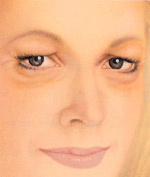
As people age, the eyelid skin stretches, muscles weaken, and fat accumulates around the eyes, causing “bags” above and below.
Blepharoplasty is one of the most common procedures performed at plastic surgicentre in Doha, Qatar. Eyelid surgery (technically called blepharoplasty) is a procedure to remove fat-usually along with excess skin and muscle-from the upper and lower eyelids. Eyelid surgery can correct drooping upper lids and puffy bags below your eyes-features that make you look older and more tired than you feel, and may even interfere with your vision. However, it won’t remove crow’s feet or other wrinkles, eliminate dark circles under your eyes, or lift sagging eyebrows. While it can add an upper eyelid crease to Asian eyes, it will not erase evidence of your ethnic or racial heritage. Blepharoplasty can be done alone, or in conjunction with other facial surgery procedures such as a facelift or brow lift. If you’re considering eyelid surgery, the following information will give you a basic understanding of the procedure-when it can help, how it’s performed, and what results you can expect. It can’t answer all of your questions, since a lot depends on the individual patient and the surgeon. Please ask your surgeon about anything you don’t understand.
The best candidates for eyelid surgery
Blepharoplasty can enhance your appearance and your self-confidence, but it won’t necessarily change your looks to match your ideal, or cause other people to treat you differently. Before you decide to have surgery, think carefully about your expectations and discuss them with your surgeon.
The best candidates for eyelid surgery are men and women who are physically healthy, psychologically stable, and realistic in their expectations. Most are 35 or older, but if droopy, baggy eyelids run in your family, you may decide to have eyelid surgery at a younger age.
A few medical conditions make blepharoplasty more risky. They include thyroid problems such as hypothyroidism and Graves’ disease, dry eye or lack of sufficient tears, high blood pressure or other circulatory disorders, cardiovascular disease, and diabetes. A detached retina or glaucoma is also reason for caution; check with your ophthalmologist before you have surgery.
All surgery carries some uncertainty and risk
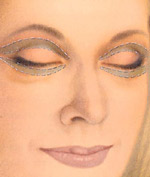
Before surgery, the surgeon marks the incision sites, following the natural lines and creases of the upper and lower eyelids.
Before surgery, the surgeon marks the incision sites, following the natural lines and creases of the upper and lower eyelids.
When eyelid surgery is performed by a qualified plastic surgeon, complications are infrequent and usually minor. Nevertheless, there is always a possibility of complications, including infection or a reaction to the anesthesia. You can reduce your risks by closely following your surgeon’s instructions both before and after surgery.
The minor complications that occasionally follow blepharoplasty include double or blurred vision for a few days; temporary swelling at the corner of the eyelids; and a slight asymmetry in healing or scarring. Tiny white heads may appear after your stitches are taken out; your surgeon can remove them easily with a very fine needle.
Following surgery, some patients may have difficulty closing their eyes when they sleep; in rare cases this condition may be permanent. Another very rare complication is ectropion, a pulling down of the lower lids. In this case, further surgery may be required.
Planning your surgery
The initial consultation with your surgeon is very important. The surgeon will need your complete medical history, so check your own records ahead of time and be ready to provide this information. Be sure to inform your surgeon if you have any allergies; if you’re taking any vitamins, medications (prescription or over-the-counter), or other drugs; and if you smoke.
Underlying fat, along with excess skin and muscle, can be removed during the operation.
In this consultation, Dr. Makki will test your vision and assess your tear production. You should also provide any relevant information from your ophthalmologist or the record of your most recent eye exam. If you wear glasses or contact lenses, be sure to bring them along.
You and your surgeon should carefully discuss your goals and expectations for this surgery. You’ll need to discuss whether to do all four eyelids or just the upper or lower ones, whether skin as well as fat will be removed, and whether any additional procedures are appropriate.
Dr. Makki will explain the techniques and anesthesia he will use, the type of facility where the surgery will be performed, and the risks and costs involved. (Note: Most insurance policies don’t cover eyelid surgery, unless you can prove that drooping upper lids interfere with your vision. Check with your insurer.)
Don’t hesitate to ask Dr. Makki any questions you may have, especially those regarding your expectations and concerns about the results.
Preparing for your surgery
Dr. Makki will give you specific instructions on how to prepare for surgery, including guidelines on eating and drinking, smoking, and taking or avoiding certain vitamins and medications. Carefully following these instructions will help your surgery go more smoothly.
While you’re making preparations, be sure to arrange for someone to drive you home after your surgery, and to help you out for a few days if needed.
Where your surgery will be performed
Eyelid surgery may be performed in a surgeon’s office based facility, an outpatient surgery center, or a hospital. It’s usually done on an outpatient basis; rarely does it require an inpatient stay.
Types of anesthesia
Eyelid surgery is usually performed under local anesthesia-which numbs the area around your eyes-along with oral or intravenous sedatives. You’ll be awake during the surgery, but relaxed and insensitive to pain. (However, you may feel some tugging or occasional discomfort.) Some surgeons prefer to use general anesthesia; in that case, you’ll sleep through the operation.
The surgery
The surgeon closes the incisions with fine sutures which will leave nearly invisible scars.
Upper Blepharoplasty usually takes between twinty and thirty minutes. Lower Blepharoplasty usually takes one to one and half hour , depending on the extent of the surgery. If you’re having all four eyelids done, Dr. Makki will probably work on the upper lids first, then the lower ones.
In a typical procedure, Dr. Makki makes incisions following the natural lines of your eyelids: in the creases of your upper lids, and just below the lashes in the lower lids. The incisions may extend into the crow’s feet or laugh lines at the outer corners of your eyes. Working through these incisions, Dr. Makki separates the skin from underlying fatty tissue and muscle, removes excess fat, and often trims sagging skin and muscle. The incisions are then closed with very fine sutures.
If you have a pocket of fat beneath your lower eyelids but don’t need to have any skin removed, Dr. Makki may perform a transconjunctival blepharoplasty. In this procedure the incision is made inside your lower eyelid, leaving no visible scar. It is usually performed on younger patients with thicker, more elastic skin.
After your surgery
After surgery, Dr. Makki will probably lubricate your eyes with ointment and may apply a bandage. Your eyelids may feel tight and sore as the anesthesia wears off, but you can control any discomfort with the pain medication prescribed by your surgeon. If you feel any severe pain, call your surgeon immediately.
In a transconjunctival blepharoplasty, a tiny incision is made inside the lower eyelid and fat is removed with fine forceps. No skin is removed, and the incision is closed with dissolving sutures.
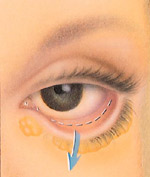
In a transconjunctival blepharoplasty, a tiny incision is made inside the lower eyelid and fat is removed with fine forceps. No skin is removed, and the incision is closed with dissolving sutures.
Dr. Makki will instruct you to keep your head elevated for several days, and to use cold compresses to reduce swelling and bruising. (Bruising varies from person to person; it reaches its peak during the first week, and generally lasts anywhere from two weeks to a month.) You’ll be shown how to clean your eyes, which may be gummy for a week or so. Many doctors recommend eye drops, since your eyelids may feel dry at first and your eyes may burn or itch. For the first few weeks you may also experience excessive tearing, sensitivity to light, and temporary changes in your eyesight, such as blurring or double vision.
Dr. Makki will follow your progress very closely for the first week or two. The stitches will be removed two days to a week after surgery. Once they’re out, the swelling and discoloration around your eyes will gradually subside, and you’ll start to look and feel much better.
Getting back to normal
After surgery, the upper eyelids no longer droop and the skin under the eyes is smooth and firm.
You should be able to read or watch television after two or three days. However, you won’t be able to wear contact lenses for about two weeks, and even then they may feel uncomfortable for a while.
Most people feel ready to go out in public (and back to work) in a week to ten days. By then, depending on your rate of healing and your doctor’s instructions, you’ll probably be able to wear makeup to hide the bruising that remains. You may be sensitive to sunlight, wind, and other irritants for several weeks, so you should wear sun glasses and a special sun block made for eyelids when you go out.
Dr. Makki will probably tell you to keep your activities to a minimum for three to five days, and to avoid more strenuous activities for about three weeks. It’s especially important to avoid activities that raise your blood pressure, including bending, lifting, and rigorous sports. You may also be told to avoid alcohol, since it causes fluid retention.
Your new look
Healing is a gradual process, and your scars may remain slightly pink for six months or more after surgery. Eventually, though, they’ll fade to a thin, nearly invisible white line.
On the other hand, the positive results of your eyelid surgery-the more alert and youthful look-will last for years. For many people, these results are permanent.
The information on this web site is only intended as an introduction to this procedure and should not be used to determine whether you will have the procedure performed nor as a guarantee of the result.
The best method of determining your personal options is to schedule a personal consultation with Dr. Makki. He will be able to answer specific questions related to your situation.
Please don’t hesitate to call for any questions that you might have
Botox Injection
Botox injection is commonly performed at plastic surgicentre in Doha, Qatar.

Botox injection is commonly performed at Plastic Surgicentre in Doha, Qatar.
Botulinum toxin (Botox) is a toxin produced by the bacterium Clostridium botulinum. It causes muscle paralysis.
Botox was originally introduced for the safe and effective treatment of muscle spasms. In patients treated for hemifacial spasm it was noted that facial wrinkling decreased over the treated muscle. This experience lead to the development of Botox for the treatment of facial wrinkles. People often dislike their central frown line, which is caused by concentrating, squinting, or frowning. Botox injections can successfully reduce its prominence.
Botox can also be used to lessen crow’s feet and other expression lines.
Tiny quantities of the toxin are injected directly into the muscles of facial expression. It takes three small injections between the eyebrows to treat the frown line. The treated muscles weaken over the following week or so. Most people do not notice anything. They simply become aware that they are no longer able to contract the frown muscles. They can still lift their eyebrows normally and blink without problems. The injection is almost painless.
It is important to remain upright for four hours after the injection. The treated areas should not be touched.
The effect lasts between four and six months. Treatment can be repeated as required.
Studies have also suggested that Botox is effective in relieving migraine headaches, excessive underarm sweating and muscle spasms in the neck and eyes.
Some people have a slight headache after treatment for several hours. The most common significant complication, which is rare, is “ptosis”. This is a drooping of the eyelid caused by the Botox tracking into the eyelid muscle. It generally lasts just a few days, but more prolonged weakness is possible.
Botox injections cannot be used in pregnancy or when breast feeding.
The information on this web site is only intended as an introduction to this procedure and should not be used to determine whether you will have the procedure performed nor as a guarantee of the result.
The best method of determining your personal options is to schedule a personal consultation with Dr. Makki. He will be able to answer specific questions related to your situation.
Please don’t hesitate to call for any questions that you might have
Injectable Dermal Fillers
Different injectable fillers are commonly used at Plastic Surgicentre in Doha, Qatar.

Injectable filler or fat can help improve the skin’s texture by filling in the laugh lines and facial creases that often occur with aging.
Fillers are used primarily to fill wrinkles, lines and scars on the face and sometimes the neck, back and chest.
It is effective for treating:
- Frown Lines
- Glabellar Lines
- Acne Scars – Trauma Scars
- Periorbital Lines (Crow’s Feet)
- Perioral Lines
- Nasolabial Folds (Smile Lines)
- Vermillion Border (Lip Lines) 8. Melolabial Lines (Marionette Lines)
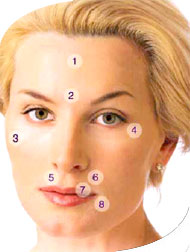
1. Frown Lines 2. Glabellar Lines 3. Acne Scars – Trauma Scars 4. Periorbital Lines (Crow’s Feet) 5. Perioral Lines 6. Nasolabial Folds (Smile Lines) 7. Vermillion Border (Lip Lines) 8. Melolabial Lines (Marionette Lines)
Injectable filler or fat can help improve the skin’s texture by filling in the laugh lines and facial creases that often occur with aging.
The Filler is injected using a fine needle inserted at several points along the edge of the treatment site. If a local anesthesia has not been used, you may feel some minor stinging or burning as the injections are administered.
Years of squinting and other facial muscle movements can take their toll on the eye area, leaving crow’s feet and other noticeable lines.
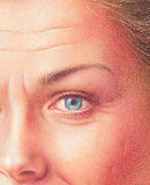
Years of squinting and other facial muscle movements can take their toll on the eye area, leaving crow’s feet and other noticeable lines.
Immediately following treatment, you may notice some minor discomfort, or stinging in the injected area. Occasionally some bruising or swelling will occur, but it is usually minor. Any redness that appears in the injected site usually disappears within 24 hours. However, in some individuals, particularly fair-skinned patients, this redness may persist for a week or more.
No bandaging is needed and you are free to eat, drink, and wear makeup with sunblock protection shortly thereafter. There may be some temporary swelling and redness in the treated area which should dissipate within a few days. If these symptoms persist, contact your surgeon.
With regular follow-up treatments, your refreshed look can be easily maintained. As stated earlier, the duration of results from injections is variable.

With regular follow-up treatments, your refreshed look can be easily maintained. As stated earlier, the duration of results from injections is variable.
Your doctor can help you determine how long you can go between treatments to best maintain your results.
The information on this web site is only intended as an introduction to this procedure and should not be used to determine whether you will have the procedure performed nor as a guarantee of the result.
The best method of determining your personal options is to schedule a personal consultation with Dr. Makki. He will be able to answer specific questions related to your situation.
Please don’t hesitate to call for any questions that you might have
PRP Therapy
Cosmetic Platelet Rich Plasma (PRP) Facial Rejuvenation
PRP Therapy, sometimes called a Vampire, is now available at PLASTIC SURGICENTRE.
As we age, most of us experience a loss of volume and skin integrity that results in common cosmetic complaints, which include the following:
- Crow’s feet
- Lip and frown lines
- Deep depressions around the nose and mouth
- Volume loss in the cheeks
- Sagging around the jaw line
- Dehydrated skin
- Overall loss of healthy, youthful skin texture and tone
The natural aging process can be accelerated by genetics, facial expressions and extrinsic factors like a poor diet, smoking and sun exposure. These all cause oxidative stress, a key component of the aging process, that appears as fine lines, hyperpigmentation, unevenness of skin tone, sagging skin and advanced wrinkling.
platelet rich plasma (PRP) , our own body’s natural source for rejuvenation. With PRP therapy, we stimulate long-term collagen growth; in turn, providing a more youthful look.
Using PRP is relatively new in cosmetic procedures; but it has been well-tested in healing sports-related injuries. Many professional athletes, as well as everyday patients, are benefitting from platelet rich paired with corrective surgery. We now have a solid history of: muscles; tendons; and ligaments healing faster with PRP therapy. It’s no surprise PRP is also providing very promising results in cosmetic enhancements.
Platelet rich plasma (PRP) is an extract of your own blood that contains three to five times more platelets, growth factors, and active proteins for tissue and injury healing. When PRP is placed back into the skin by injection or micro-needling, it initiates a localized stem cell response. Over the weeks and months following treatment, this stem cell response recruits collagen-producing cells called fibroblasts. The fibroblasts replace tissue that has been damaged or lost through the aging process with healthy skin that looks refreshed and rejuvenated.
The potential benefits of PRP have led to a recent widespread interest in its use for anti-aging and regenerative purposes. The healing properties of the blood components in PRP can be used as a cosmetic treatment for the following:
- Reducing fine lines and wrinkles
- Tightening and toning skin
- Mild collagen and volume loss
- Crow’s feet and dark under eye circles
- Acne scarring
- Rosacea
Within a few weeks of treatment, an overall improvement in skin hydration, texture and tone can be seen. New collagen and blood vessels begin to grow after three to six weeks, and reduction of fine lines and wrinkles and volume correction happens over the next three to six months. The effects of Cosmetic PRP can last 12 months to two years, depending on the individual. While it creates a longer-lasting effect in the skin, it does take time to work. For women looking for an immediate effect, Cosmetic PRP can be combined with hyaluronic acid fillers for quick volume correction. Fillers provide a matrix for building new collagen and can be used to accelerate and sustain the benefits of Cosmetic PRP.
What can you expect during an office visit for platelet rich plasma? First, we draw a small amount (about 10cc) of blood. The blood is collected in a specially prepared test tube, containing a separating gel that helps collect the precious platelets. The separation process, requiring a centrifuge, takes approximately 9 minutes. Once the PRP serum is ready, it’s placed in a syringe; and ready for injection. The serum is thin enough to use a very narrow needle — the same, small-caliber, needle size normally used to administer Botox. We then inject the PRP into the areas you want to improve, along small lines and wrinkles. We can treat your entire face for rejuvenation.
Unlike Botox and fillers, please be aware there is a recovery period involving swelling; and in some cases, bruising. PRP does cause an inflammatory response; so this is expected. This swelling should subside in 3 to 7 days. Applying cold compresses, elevating your head, and using arnica cream can minimize any swelling and bruising. Once these effects subside, patients will notice that lines and wrinkles have softened; and areas of volume loss, such as nasolabial (the area between your nose and upper lip) folds, look fuller.
Results vary from patient to patient, depending on factors such as: age; overall health & nutrition; and genetics. In general, usually over a 3 to 4 week interval, patients should be able to see improvements in: skin texture; complexion; and tone. These improvements can continue for up to a year.
We at PLASTIC SURGICENTRE are excited to continue to strive on the cutting edge of the most advance technology.
For more information about Cosmetic PRP or to book your consultation, please contact PLASTIC SURGICENTRE
Forehead Lift- Brow Lift
Brow lift also known as forehead lift or browplasty,

A forehead lift can smooth the forehead, raise the upper eyelids, and minimize the frown lines that come with aging
A brow lift or forehead lift reverses the effects of gravity and tightens the soft tissues of the forehead to restore a more youthful contour to your forehead skin, upper eyelids and eyebrows. There are various brow-lift methods, which involve different length incisions in different locations and, sometimes, an endoscope. A youthful brow at rest is positioned above the orbital rim, with a gradual arch laterally, and the lateral end or ‘tail’ of the brow located higher than the medial end. As one ages, it is common for the brow to assume a flat or horizontal position. If a sagging brow inhibits your facial expression, a brow lift is a time-tested method for rejuvenating the upper third of your face. Every year, thousands of people undergo successful brow-lift surgery and are pleased with the results
When to Consider a Brow Lift
Sagging or low eyebrow position creates a tired, sad or grumpy appearance
You have deep horizontal creases across the forehead
You have frown lines or furrows between the eyebrows or across the top of your nose
You have excess skin or fatty tissue hanging over your eyes
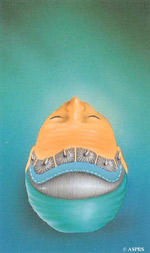
In preparation for a forehead lift, the hair is tied back with rubber bands in front of and behind the incision area. An incision is usually made across the top of the head, just behind the hairline.
Related Procedures:
Many people who consider a brow lift also consider a facelift, blepharoplasty (eyelid surgery) and fillers.
Considerations:
Pros
Repositions a low or sagging brow that hangs over the upper eyelid
Raises the eyebrows to a more alert and youthful position
Makes you look happier, friendlier and more approachable
Cons
Only a highly experienced board-certified plastic surgeon can determine if this procedure will achieve your goals.
Choice of brow-lift technique is very important to outcome, so this procedure is very clinician dependent.
You may also need blepharoplasty (eyelid surgery), as a forehead lift does not improve baggy eyelids or crow’s feet
These are the top three pros and cons to weigh when considering a brow lift. If you want to focus on what is unique to you, please consult with one of our aesthetic plastic surgeons at PLASTIC SURGICENTRE.
Am I a good candidate for a brow lift?
The following are some common reasons why you may want to consider a brow lift:
The outside of your brow sags, resulting in a sad expression.
The central portion of your brow hangs down, making you look angry
You have frown lines between your eyes.
If you are a female and you are unable to apply makeup on the upper eyelid, because the surface area has been obscured by drooping tissues as you have aged.
If you gently lift the skin above your eyebrow into a pleasing position and it eliminates most of the excess skin in your upper eyelid, a brow lift may be right for you.
Rely on an evaluation from a board-certified plastic surgeon to find out if you would benefit from a brow lift, blepharoplasty, or both procedures. If you are in good general health, have a positive attitude and realistic expectations, you are most likely a good candidate for brow lift and eyelid surgery procedures.
How is a brow lift procedure performed?
Brow-lift procedures have evolved from open techniques to more complex short incision and endoscopic techniques. A brow lift usually involves incisions in the hair-bearing scalp, but sometimes incisions are made in the forehead and/or the upper eyelids.
Open brow lift. Your surgeon makes a long incision across the forehead, either around the hairline or in one of the creases of the forehead, and lifts the skin away from the underlying tissues. The surgeon then loosens muscles and removes fat. He or she removes any excess skin, pulls the remaining skin down, and stitches the brow into its new position. Other names sometimes used to describe open brow lift include classic, coronal or trichophytic brow lift.
Endoscopic brow lift. Your surgeon will insert an endoscope (a long, thin tube with a light at the end attached to a video camera) through several tiny incisions in the scalp. This allows your surgeon to see and work on the various internal structures of the forehead. The endoscopic technique requires very minimal incisions, but it may not be equally beneficial for all patients.
Limited incision technique. This hybrid technique of both procedures is non-endoscopic with limited incisions. It uses a small portion of the ends of the coronal technique incision to elevate the outside part of the eyebrows under direct vision without an endoscope. The resulting scars are hidden in the temporal hairline, even in balding men who have little temporal hair remaining. While this procedure does not address the center area of the brow, it can reduce wrinkles at the corners of the eyes, commonly referred to as ‘crow’s feet.’ Since many forehead-lift procedures are performed with an upper blepharoplasty, the upper eyelid incisions are used to complete the forehead-lift procedure by treating the ‘frown’ lines between the eyebrows and raising the inside part of the eyebrows.
The type of brow lift you undergo will be based on your facial features and aesthetic preferences. The goal of your aesthetic plastic surgeon and the entire staff is to help you achieve the most beautiful and natural-looking results, as well as to make your surgical experience as easy and comfortable as possible.
What are my options?
Excess eyelid skin, droopy upper eyelids, and droopy eyebrows commonly occur in the same patient. It is not possible to achieve a good aesthetic and functional result unless all three problems are addressed. Your plastic surgeon will assess your problem, considering your hairline and hair style preferences, and make a recommendation that will yield the least scarring and the best cosmetic results. The basic brow-lift techniques are outlined in How is a brow lift performed? but your surgeon may suggest other variations. Here are some general guidelines:
If you have mild to moderate brow droop and horizontal wrinkles, an endoscopic lift may be a good choice.
If you have advanced brow droop with deep wrinkles, a coronal forehead lift may be most appropriate.
If you have a high forehead, to avoid raising your hairline further, you may undergo a subcutaneous lift. In this procedure, your incision is near the hairline, leaving visible scars that can be hidden with hair.
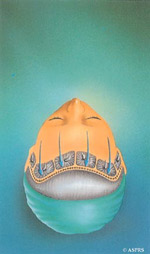
Forehead skin is gently lifted and portions of facial muscle and excess skin are removed. The incision is then closed with stitches or clips.
What will my brow lift incisions and scars be like?
The brow-lift incisions will be based on the technique your surgeon uses and will result in scars. The incisions are generally placed so they will be well concealed, frequently within or at the hairline, or within a deep forehead crease.
Open (coronal) technique. The incision is across the top of the scalp, beginning above the ears and hidden within the hair.
Endoscopic forehead lift. Your incisions may include three short incisions along the top of the scalp and a temple incision on each side. These incisions will be totally hidden within the hair.
Limited incision technique. The incisions will be hidden in the temporal hairline (temples). If your forehead lift is done in conjunction with an upper blepharoplasty, upper eyelid incisions will be used to complete the forehead lift by treating ‘frown’ lines between the eyebrows and raising the inside part of the eyebrows.
Select a surgeon you can trust
It’s important to choose your surgeon based on:
Education, training, and certification
Experience with brow lifts
Your comfort level with him or her
Your initial consultation appointment
During your initial consultation, you will have the opportunity to discuss what you want to achieve. Your surgeon will evaluate you as a candidate for brow lift and clarify what a brow lift can do for you. Once the surgeon understands your goals he or she may suggest additional or related procedures. It is important to be completely honest during the consultation. Also, bring pictures of yourself at an earlier age; they may serve as a good point of reference for discussing your goals. It’s a good idea to be fully prepared to answer these questions:
Do you have any medical conditions or drug allergies? Are you being treated for any medical conditions?
Have you had any previous surgeries?
What are your current medications and vitamin and herbal supplements?
What is your current use of alcohol, tobacco, and recreational drugs?
What is your history with any noninvasive cosmetic procedures?
What outcome do you expect from the surgery? What is your chief motivation in undergoing brow-lift surgery?
Your surgeon may also:
Ask you to look in a mirror and point out exactly what you would like to see improved.
Take photos for your medical record, measure your face, and use computer imaging to show you the improvements you can expect
Evaluate your health status, including pre-existing health conditions or risk factors
Evaluate the elasticity of your skin
Discuss your options and recommend a course of treatment
Discuss likely outcomes, including risks or potential complications
Discuss the type of anesthesia that will be used
Your treatment plan
Based on your goals and physical characteristics, and the surgeon’s years of training and experience, your surgeon will share recommendations and information with you, including:
An approach to your surgery, including the type of procedure or combination of procedures
The outcomes that you can anticipate
Your financial investment for the procedures
Associated risks and complications
Options for anesthesia and surgery location
What is needed to prepare for the surgery
What you can expect to experience after surgery
Share before-and-after photos of cases similar to yours and answer any questions.
How do I prepare for a brow lift procedure?
Your surgeon will provide thorough preoperative instructions, answer any questions you may have, take a detailed medical history, and perform a physical exam to determine your fitness for surgery. Here are some of the preoperative instructions you can expect:
If you smoke, your surgeon will ask you to stop at least six weeks before your surgery. Smoking greatly increases the risk of complications and slows the healing process.
You may have to limit alcohol consumption and avoid certain medications.
If you regularly take aspirin or another anti-inflammatory drug, your surgeon will ask you to stop taking these for a period before surgery. These drugs can cause increased bleeding.
Regardless of the type of surgery to be performed, hydration is very important before and after surgery for safe recovery.
If your hair is short, you may want to grow it out to cover any scars.
Make arrangements to be driven to and from surgery on the day of your procedure.
You should have someone to take care of you on your first night home and, if possible, the first two days following surgery.
Fill all prescriptions before surgery.
Set up your recovery area ahead of time. You should have easy access to fluids, prepared meals, pillows to elevate your head, and reading materials and entertainment.
Prepare ice packs. Frozen vegetables work well to reduce postoperative swelling.
What can I expect on the day of brow-lift surgery?
A brow lift may be performed in a surgeon’s office-based facility, an outpatient surgical center, or a hospital, and can take one to three hours to complete.
Medications will be administered for your comfort during the surgical procedure.
Local anesthesia combined with sedation is commonly used during brow-lift surgery, though general anesthesia can be used instead.
For your safety during the surgery, various monitors will check your heart, blood pressure, pulse, and the amount of oxygen circulating in your blood.
An anesthesiologist or nurse anesthetist will be present to administer sedatives (or general anesthetic) and assist in monitoring.
Your plastic surgeon will follow the surgical plan discussed with you before your operation. Once surgery has begun, the surgeon may decide to combine various techniques or change a technique to ensure the best result. It is important that you feel comfortable and trust your doctor to make these decisions.
Sections of hair will be held away from the surgery area.
After removing excess tissue, skin, and muscle, your surgeon will close the incision with stitches or staples. Your hair and face will be washed so the scalp skin does not get irritated.
The treated area will be wrapped with a sterile padding and an elastic bandage to prevent bleeding and swelling (edema). You will have sutures and a dressing on your forehead for the first few days after surgery. After surgery, you will be taken into a recovery area where you will continue to be closely monitored.
You can control temporary discomfort in the surgical site with medication. You may choose to go home on the day of surgery or spend the night with an office consultant or nurse, unless you and your plastic surgeon have made other plans for your immediate postoperative recovery. Under no circumstance will you be permitted to go home alone.

The result of a forehead lift is a younger, more rested look.
Aftercare and Recovery
Your surgeon will discuss how long it will be before you can return to your normal level of activity and work. After surgery, you and your caregiver will receive detailed instructions about your postsurgical care, including information about:
Incision care
Normal symptoms you will experience
Any potential signs of complications
It is vitally important that you follow all patient care instructions provided by your surgeon, and that you realize that the amount of time it takes for recovery varies greatly among individuals.
Immediately after your brow lift
Your surgeon may suggest icing or cold packs around the eyes for forty-eight hours to reduce the swelling.
It is best to sleep with your back and head elevated for approximately five to seven days.
Your surgeon will likely ask you to come back to his office a day or two after surgery so he or she can evaluate your healing.
Pain is typically not a significant problem in brow lifts. There is, however, some discomfort and tightness from ear to ear across the top of the head and brow. Most patients describe their forehead as feeling tight and somewhat numb the night of surgery. You will be provided with pain medications should you need them.
Drains are usually not needed in the brow area when doing a brow lift.
Temporary bruising, swelling, and numbness are common the first night after surgery. Maximum swelling occurs forty-eight to seventy-two hours post-surgery and begins to subside on the fourth or fifth postoperative day.
You may need to go to the bathroom frequently because of the intravenous fluids you were given during your surgery. Drink plenty of fluids to keep up with the fluid loss. As your body begins to balance itself, it will rid itself of this extra ‘water weight’ and return to normal.
Bruising from a brow lift appears less in the brow than in neighboring areas. As a result, any bleeding usually collects below the eyelids and bruises the lower lids, even if the lower lids are not operated on. Bruising usually peaks on the third to fifth day and resolves over two to three weeks.
Showering and bathing are permitted the next day after surgery. Use hair conditioner to help wash and clean hair that became matted or knotted during surgery. Be cautious when applying hot water, hair dryers, and combs; your scalp will be numb, so they may damage your skin and/or hair.
Recovery time frame following a brow lift
Your sutures or staples will be removed approximately one week after surgery.
During the first week of recovery, you should move and be mildly active, including going for walks to aid circulation in your lower extremities. However, do not attempt heavy lifting or strenuous activity.
You can resume driving when you are able to drive as well as you did before surgery. You need to be able to brake, respond, and turn quickly. When these conditions are met, you may resume driving, typically in the second or third week after surgery.
You may be able to return to work within a week and to full activity within a few weeks, but you must avoid heavy lifting or straining during this time.
Sensation in your scalp may be temporarily reduced. The feeling will begin to return over the first few weeks after surgery and your scalp will begin to feel ‘itchy’ as the nerves reawaken. Total numbness behind the incision in an open brow lift will usually persist for nine to twelve months post-surgery, sometimes longer in rare instances.
One month following surgery
You should have returned to your normal rhythm at work by this time, depending on the amount of physical exertion required to perform your duties.
Begin exercise and workout routines. Avoid any activity that causes discomfort and/or pain until you are further along in your recovery process. When you return to the activity, start at half speed and increase to your normal routine as long as you do not feel any pain during and/or the day after your workout.
How long will my results last:
Usually, you can expect the final result from surgery to be evident after six months. By then, the scalp and hairline incisions will have healed completely and you should be enjoying your more youthful appearance. Gravity will take its toll as aging continues, but portions of the brow lift, especially wrinkle lines in the brow and the frown line area, should never be as severe again and may return only mildly over the years. Life-long sun protection and a healthy lifestyle will help to maintain and extend the results of your more youthful appearance.
Maintain a relationship with your aesthetic plastic surgeon
For safety, as well as the most beautiful and healthy outcome, it is important to return to your plastic surgeon’s office for follow-up evaluation at prescribed times and whenever you have any questions about your brow-lift healing and results.
Limitations and Risks:
Fortunately, significant complications from brow-lift surgery are infrequent. This surgery is usually performed without any major problems.
Risks and potential complications of surgery is should be discussed during your consultation. The risks in most surgeries are similar. Some of the potential complications of all surgeries are:
Adverse reaction to anesthesia
Hematoma or seroma (an accumulation of blood or fluid under the skin that may require removal)
Infection and bleeding
Changes in sensation
Scarring
Allergic reactions
Damage to underlying structures
Unsatisfactory results that may necessitate additional procedures.
You can help minimize certain risks by following the advice and instructions of your board-certified plastic surgeon, both before and after your brow-lift surgery.
The information on this web site is only intended as an introduction to this procedure and should not be used to determine whether you will have the procedure performed nor as a guarantee of the result.
The best method of determining your personal options is to schedule a personal consultation with Dr. Makki. He will be able to answer specific questions related to your situation.
Please don’t hesitate to call for any questions that you might have
Lip Augmentation
Lip augmentation is commonly performed at plastic surgicentre in Doha, Qatar. Lip
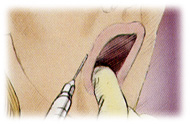
Lip Augmentation
augmentation is a procedure to increase the size of the lips in order to make them more full and voluptuous. It often involves putting something into the lips to fill them up. A variety of substances have been used for this purpose including fat or fibrous tissue from your own body, or other materials such as collagen, silicon, goretex fibers, etc. In addition, there are surgical techniques for bringing some of the tissue from the inside part of the lip out to make the lip look bigger.
If you are self-conscious about your lips, then this surgery can open up many new possibilities for changing your image, and you can further enhance them with new lipstick, makeup, etc. As with most cosmetic surgery, the benefit you derive will depend upon the change in attitude that you will have about yourself as a result of the surgery.
Technique:
A natural or synthetic biocompatible material, or the patient’s own fat, is injected or implanted in the lips. One injection is usually sufficient to produce the desired result, which may be temporary, depending on the material used. Injections may need to be repeated periodically. Proper placement of the injected material is important. AlloDerm, a natural collagen sheet made from donated skin, is inserted through tiny incisions inside the corners of the mouth. Once the AlloDerm implant is in place, it eventually becomes integrated with the natural tissues. Gore-Tex, SoftForm and soft ePTFE are other synthetic implant options.
Further options include:
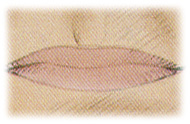
Lip Augmentation
Autologen – injectable dermal implant material made from the patient’s own skin.
Dermalogen – injectable Human Tissue Matrix (HTM) procured from donor tissue.
Fascia – injectable donor tissue made from the dense white connective tissue that supports body structure. Can also be done as a surgical implant.
HylaForm – a crystal-clear injectable gel; the hyaluronic acid in Hylaform is similar to that naturally found in the body.
Radiance – calcium hydroxylapatite
Restylane – crystal-clear injectable gel; the hyaluronic acid in Restylane is very close to that naturally found in the body.
Another augmentation choice is laser lip rejuvenation, which tightens the natural collagen and elastic tissue beneath the lips.
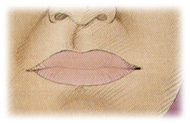
Lip Augmentation
Benefits:
Immediate return to normal activities (one-day return if sedated) for nonsurgical procedures; depending on the procedure and materials used, recovery period is within a week for surgical procedures.
AlloDerm and Dermalogen do not require patients to provide donor tissue and are not rejected by the body, because they are human tissue. Usually they have a pliable, natural feel.
Gore-Tex implants are permanent, easily inserted and well tolerated by the body.
Temporary procedures like collagen or fat injection can be appealing to patients who want to experiment with a fuller-lipped look, but not necessarily commit to it.
Other Considerations:
Allergic reactions can range from prolonged redness, swelling or itching, to firmness at the injection site. Other possible complications include bleeding, lip asymmetry, and migration and extrusion of the implant. Normal swelling and bruising lasts from three days to a week.
Patients with a reaction to the pre-treatment collagen skin test; who have a serious allergy history; or are allergic to lidocaine (a local anesthetic) should not consider lip augmentation. Treatment is sometimes postponed for patients with active inflammatory skin conditions or with infections.
Collagen injections have a short-lived effect (9-12 weeks); fat injections provide longer-lasting results, but are sometimes unpredictable as to the degree of improvement, can have lumping or scarring effects, and must be harvested from another part of the body.
Soft-form is a foreign body and may become infected or be rejected. While many techniques exist for lip augmentation, none are ideal.
Several alternatives exist. Lipstick and makeup may be used to make the lips appear larger than they are. Tattooing of the lips has also been done in order to give the appearance of larger size. Surgical correction includes filling the lips or in rolling tissue from the inside of the lip towards the outside.
Fortunately, although the lips are quite sensitive, they are not too sensitive to small cuts (which happen all the time from the teeth), and pain after the surgery is usually quite minimal. During the surgery, of course, the lip would be numb, and it would not hurt at all.
Unfortunately, the results will not last forever. The body is always changing, and will absorb fat or collagen that is placed in the lips. In addition, the lips get smaller with age, and surgery will not halt this process.
You may decide to make the lips too big at first, in order to have the augmentation last longer. In this case, you may look a bit peculiar for the first few days after the surgery, and may want to stay home from work. Most normal activities can be resumed within a few days.
The information on this web site is only intended as an introduction to this procedure and should not be used to determine whether you will have the procedure performed nor as a guarantee of the result.
The best method of determining your personal options is to schedule a personal consultation with Dr. Makki. He will be able to answer specific questions related to your situation.
Please don’t hesitate to call for any questions that you might have
Lip Reduction
Lips reduction is a procedure performed to reduce the overall size of the lips in people who feel that their lips are simply too large. While it is much more common for us to increase the size of lips with filler products, patients occasionally request this operation. The best candidate is a patient whose lips are proportionately larger than the other structures on their face.
The operation can be done under local anesthesia with or without sedation. It involves incisions on the inside of the lips, with removal of excess tissues. These incisions are well hidden inside the mouth so there are no scars visible. The procedure lasts less than one hour and while the lips are swollen for two to four days after surgery, the result is apparent immediately thereafter.
The information on this web site is only intended as an introduction to this procedure and should not be used to determine whether you will have the procedure performed nor as a guarantee of the result.
The best method of determining your personal options is to schedule a personal consultation with Dr. Makki. He will be able to answer specific questions related to your situation.
Please don’t hesitate to call for any questions that you might have
Feather lift (threads lifting)

Brow Lift
Thread lifting is commonly performed at plastic surgicentre in Doha, Qatar.
What is “Thread-Lift” ?
The “Feather-Lift” is a non-surgical approach to facial lifting utilizing the patented threads.
What are Threads?
The threads are made of a monofiliment material called “polypropylene”. The threads are designed with directional cogs. Once inserted under the skin, The thread cogs will form a support structure for the tissue of the face.
Who is the best candidate ?
Patients with:
Drooping of the soft tissue of the face and neck.
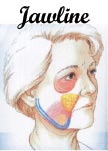
Jawline
Weakly pronounced aesthetic contours.
Flaccid, flat face.
Premature aging and sun damaged face.

Malax
Is it hard to perform ?
This procedure is safe, quick and easy to perform. Performed under local anesthesia and if desired, light IV sedation, the patient remains awake and alert. Using a needle, the threads are inserted into the subcutaneous fat, at a required depth, along the contours that were previously marked.
How does the “Thread-Lift” differ from conventional face lift ?
No scars.
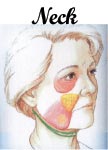
Neck
Minimal discomfort.
Quick recovery, patients may return to work in less than a week.
Uniform gathering and even lifting of the soft tissues for a new volumetric contour of the face.
Reshape Chin, Cheek, Jaw

Facial implants
Implants are inserted behind facial muscles to build up cheekbones or receding chin or reshape jaw line.
Recovery: Most swelling gone in two to four weeks; guard against bumping for six weeks or more. Swelling, bruising, numbness, stiffness, inability to fully open mouth may last several weeks.
Comment: In the newest techniques, implants are inserted through the mouth to avoid external scarring.
Risks: Infection; shifting or imprecise positioning of implant, requiring removal or second operation. Hardening of scar tissue around implant could cause unnatural appearance.
Permanence: For life.

Lifetime lasting
The information on this web site is only intended as an introduction to this procedure and should not be used to determine whether you will have the procedure performed nor as a guarantee of the result.
The best method of determining your personal options is to schedule a personal consultation with Dr. Makki. He will be able to answer specific questions related to your situation.
Please don’t hesitate to call for any questions that you might have
Cleft Lip and Palate
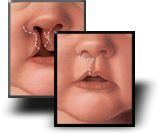
A procedure to correct cleft of the lip and or the palate in children born with this anomaly.
A procedure to correct cleft of the lip and or the palate in children born with this anomaly.
A cleft lip is an opening of the upper lip resulting from abnormal development of the lip and nose. A cleft palate is an opening in the roof of the mouth resulting from abnormal development of that area. Cleft lip and palate can occur together or separately. They are the most common forms of birth defects of the face.
Some problems can be associated with clefts of the lip and palate (such as speech, feeding and facial disfigurement), as well as more severe and complicated clefts of the face.
The information on this web site is only intended as an introduction to this procedure and should not be used to determine whether you will have the procedure performed nor as a guarantee of the result.
The best method of determining your personal options is to schedule a personal consultation with Dr. Makki. He will be able to answer specific questions related to your situation.
Please don’t hesitate to call for any questions that you might have



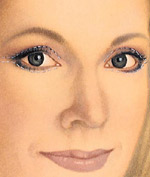
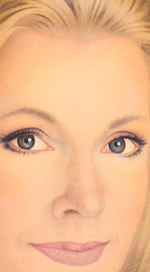
 Twitter
Twitter Facebook
Facebook Instagram
Instagram Google +
Google +